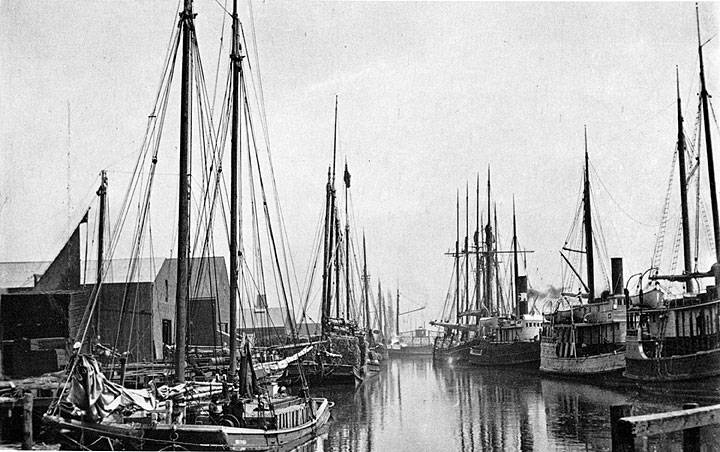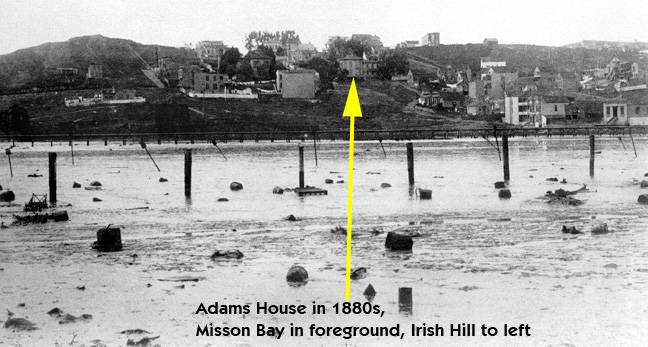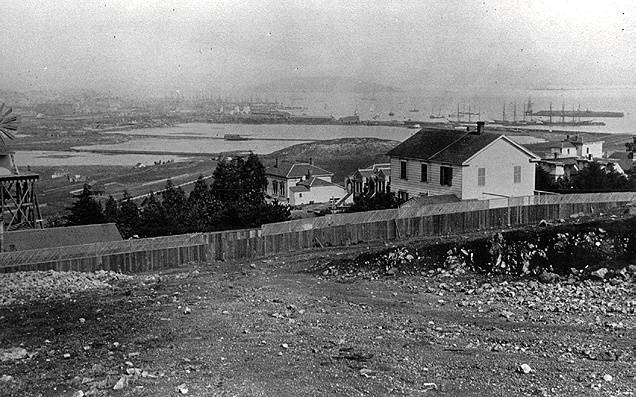The Dumps at Mission Creek
"I was there..."
by James Fell
Reverend James Fell was chaplain of the Seamen’s Institute on Steuart Street, and describes Mission Bay in his 1899 memoir British Merchant Seamen in San Francisco 1892-1898 (excerpted in More San Francisco Memoirs 1852-1899: The ripening years, compiled by Malcolm E. Barker)
Mission Creek, or Channel Street, a busy port for most of its life, seen here in the first decade of the 1900s.
Photo: National Maritime Museum, San Francisco
If ships along or near certain wharves are obliged to lie in such places, and suffer such odours, it has even been worse for the nasal organs this past year or two for the crews of those ships which have lain at anchor in Mission Bay, which is part of the Bay of San Francisco. The authorities are fi11ing up a large area of depressed land adjoining the bay-presumably to make it possible for the children of men whose smel1ing organs may not be highly developed to eventual1y build for themselves houses in which to dwell. The material used for filling up this area, which is now mud and water, and to lay a good foundation for the saloons which will without doubt appear on the surface when it is sufficiently hardened, is the garbage of the city, and daily scores of carts find their way to this historic spot [known as] 'The Dumps' and deposit their savoury burden. Probably many thousands of San Francisco people who have been in the habit of going to Potrero and Butcher Town by the car will agree that the odours from this delightful site for villa residences may be fitly described as awful.
An electric car is past in a minute, but frequently ships lie at anchor for months in Mission Bay, and then for hours, so long as the wind blows off the shore, which it does throughout the summer, they have the benefit of this cyclone of smell. Curiously, however, unlike the sewage, it does not seem to be unhealthy, and it is devoutly to be hoped, for the sake of future dwellers on this choice piece of ground, that it wil1 not prove to be so.
In this photo from the 1880s, Mission Bay can be seen as a broad shallow bay, but full of detritus and debris from the growing city. The smell of raw sewage and other waste must have been rather intense!
Photo: Private Collection
Not only are the wharves, with their peculiarities, wel1 known to sailors, but also nearly all parts of the great Bay of San Francisco, from the odoriferous Mission Bay above mentioned to Oakland Creek, where on its foul and filthy mud, ships 'lie up' for months, and where last year (1897) for a time quite an epidemic of typhoid fever raged.
View down from Potrero Hill across the slowly filling in Mission Bay. The Dumps, approximately off 5th Street, are between the two causeways crossing the water in this 1875 photo.
Photo: Private collector
Then there is the Bay of Sausalito, that favourite and sheltered spot, with its calm and delightful climate so different from Mission Bay, with its smoke, and smell, and fog, only eight miles or so away. No wonder Sausalito is the spot chosen by many captains when it is a case of 'laying up' the ship.



